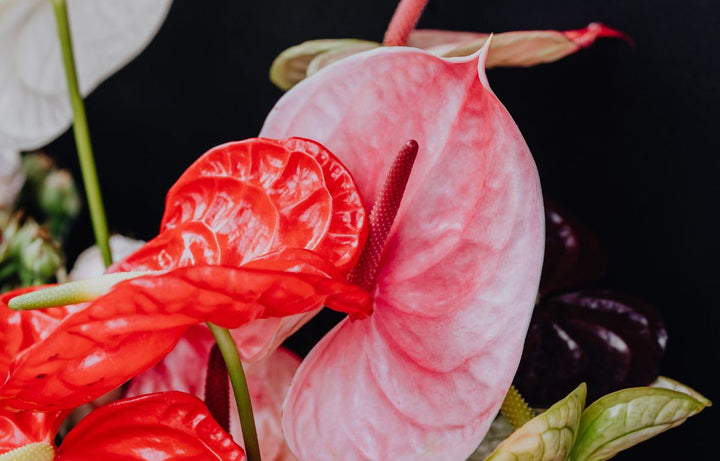
Plant Profile: Anthuriums
Plant Profile: Anthuriums
There are many reasons for the popularity of Anthuriums, primarily their stunning appearance. The glossy, heart-shaped leaves and vibrant, long-lasting blooms add a touch of tropical elegance to any indoor space. Another major drawcard is their general low-maintenance growing requirements, making them ideal for both experienced and novice plant enthusiasts alike. Lastly, Anthuriums are known for their significant air-purifying qualities. They can filter out toxins such as formaldehyde, ammonia, and xylene, improving indoor air quality.

Anthuriums belong to the Araceae family and are native to the rainforests of Central and South America. The name "Anthurium" is derived from the Greek words "anthos" (flower) and "oura" (tail), referring to the distinctive tail-like spadix that protrudes from the colourful, heart-shaped spathe. These exotic plants have evolved to thrive in the warm, humid conditions of tropical rainforests, making them well-suited for indoor cultivation.
Planting Anthuriums
Potting: Choose a pot with drainage holes to prevent waterlogging, which can lead to root rot. Anthuriums prefer being slightly root-bound, so opt for a pot that is only slightly larger than the plant's root ball.
Soil: It is always recommended to use a pre-mixed premium grade potting soil. However, you can create your own. Use a well-draining, aerated mix that retains some moisture and allows the Anthurium’s roots to breath. A mix of orchid bark, perlite, and peat moss in equal measures is suitable. Avoid materials that will make the potting mix dense and compacted.
Position: Anthuriums thrive in bright, indirect light. Place them near a north or east-facing window where they can receive filtered sunlight. Avoid exposing them to direct sunlight for extended periods, as it can scorch the leaves. Anthuriums can adapt to lower light conditions, such as those found in offices with fluorescent lighting or rooms with filtered sunlight. However, they won't do well in extremely low-light environments or completely dark spaces like their cousin, the Peace Lily.
Watering: Keep the soil consistently moist but not waterlogged. Allow the top inch of soil to dry out between waterings. Adjust the frequency based on the environmental conditions, more frequent watering may be necessary in warmer months and less frequently during the cooler ones.
Temperature: Anthuriums are native to tropical rainforests where humidity levels are consistently high. Therefore, they thrive in an environment with relatively high humidity. Ideally, Anthuriums prefer a humidity level between 60% and 80% with temperatures between 18°C to 27°C. Avoid exposing Anthuriums to drafts, sudden temperature changes, or cold temperatures below 10°C.
Fertilisation: Feed your Anthurium with a balanced and diluted, liquid fertiliser every 4-8 weeks during the growing season (spring and summer), or as directed on the packaging.
Flowering: When exposed to consistently bright, filtered sunlight, Anthuriums produce modified leaves called Spathes. These heart-shaped leaves frame a central spike, called the spadix. Although appearing as one solid protrusion, the spadix is actually made up of tiny densely packed flowers.
One of the weirder horticultural phenomenon is the ability for Araceae spadix to produce heat known as botanical thermogenesis. One of the many theories believes this ability helps strengthen the scent of the flowers in order to attract pollinators for reproduction.
Both spathe and spadix come in a variety of different colours from white, green and purple, but red and pink spathes with a cream coloured spadix are more commonly associated with Anthuriums and can last up to 2-3 months before dying back.
Pruning: Remove yellow or damaged leaves regularly to encourage new growth and maintain the plant's aesthetic appeal. Remove spent (dead) flowers with clean, sharp scissors or pruning shears. Trim the flower stalk back to the base of the plant, cutting just above the point where it emerges from the main stem.

Common Problems and Solutions
Yellowing Leaves: Overwatering is a common cause of yellowing leaves. Decrease your watering frequency and only water when the soil feel dry to the touch. If the soil has become waterlogged, add dry soil to soak up the excess water or repot your plant using new soil with a slightly moist consistency.
Root Rot: Ensure proper drainage and avoid overwatering to prevent root rot. Repot the plant if necessary using new potting soil, and trim away affected roots to stop further infection.
Pests: Watch out for pests like aphids and spider mites. Use insecticidal soap or neem oil to control infestations.
Anthuriums are not just indoor plants; they are living works of art that bring a touch of the tropics into our homes. By understanding their origins, meeting their care requirements, and addressing common issues, you can enjoy the beauty of Anthuriums for years to come. So, go ahead, embrace these exotic wonders, and elevate your green houseplant collection with some vibrant colour.
